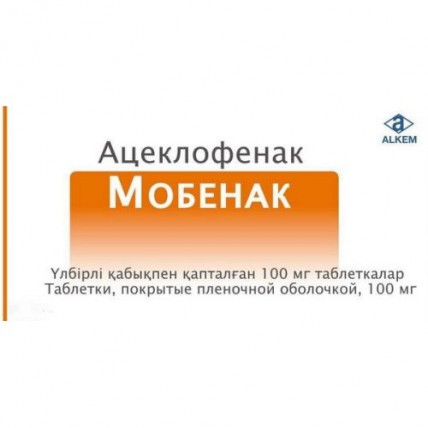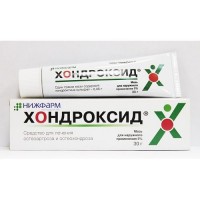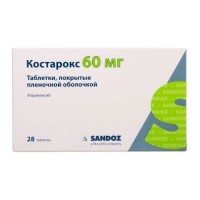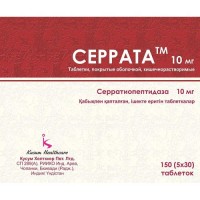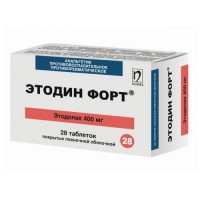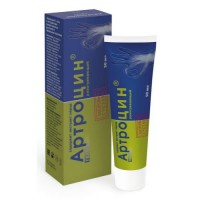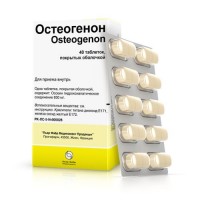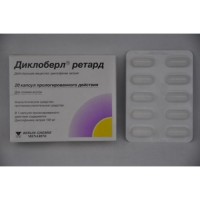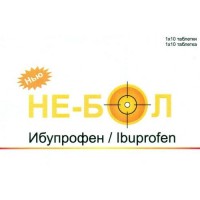Mobenak 10s 100 mg film-coated tablets
- $7.20
Trade name
Mobenak
Mezhdunarodnoye the unlicensed
name Atseklofenak Lekarstvennaya
the Tablet form, film coated, 100 mg
Structure
One tablet contains
active agent - an atseklofenak of 100 mg,
excipients: microcrystalline cellulose, polivilpirrolidon K-30, stearic acid, sodium of a kroskarmelloz, magnesium stearate.
structure of a cover: White Instacoat IC-S-223: hydroksipropilmetiltsellyuloza, polyethyleneglycol, talc, titan dioxide.
Description
Round, biconvex tablets of white color, film coated.
Pharmacotherapeutic group
Anti-inflammatory and antirheumatic drugs.
Non-steroidal anti-inflammatory drugs.
Acetic acid derivatives.
The code of automatic telephone exchange M01AB16
the Pharmacological
Atseklofenak Pharmacokinetics Absorption properties is quickly soaked up after oral administration. The bioavailability of drug is nearly 100%. Peak concentration in plasma are reached approximately in 1.25 - 3 hours after reception. Meal increases time of achievement of the maximum concentration, at the same time without influencing extent of absorption.
Distribution
Linking with proteins of blood plasma makes more than 99.7%. Atseklofenak gets into synovial fluid where its concentration makes about 60% of concentration in blood plasma. The volume of distribution is about 30 liters.
Removal
the Average time of semi-removal makes 4-4.3 hours. Speed of clearance reaches 5 liters an hour. About two thirds of a dose are removed with urine, mainly, in the form of the connected hydroxymetabolites. Only 1% of a single oral dose is removed in an invariable look.
Atseklofenak is metabolized by CYP2C9 to the main metabolite 4-OH-atseklofenaka which influence on clinical activity is insignificant. Diclofenac and 4-OH-diclofenac are found in many metabolites.
Characteristic at special groups of patients
At elderly was not observed changes of pharmacokinetic properties of an atseklofenak.
At patients with an abnormal liver function after single dose of an atseklofenak the delay of its removal was observed. At multiple dose of drug in a dosage of 100 mg differences in pharmacokinetic parameters at patients with slight and moderate cirrhosis and normal function of a liver were not observed once a day.
At patients from easy and average degree the renal failure after single dose of drug did not note clinically significant differences in pharmacokinetic parameters.
The pharmacodynamics
Atseklofenak - active ingredient of the drug Mobenak possesses the anti-inflammatory, anesthetizing and febrifugal action. Synthesis of prostaglandins oppresses and, thus, affects pathogenesis of inflammation, developing of pain and fever. In rheumatic diseases the anti-inflammatory and analgeziruyushchy action of an atseklofenak promotes considerable reduction of severity of pain, morning constraint, a swelling of joints that improves a functional condition of the patient.
Indications
- symptomatic therapy of pain and inflammation in an osteoarthrosis,
a pseudorheumatism and Bekhterev's disease
- the states which are followed by pain (toothache, extraarticular rheumatism, musculoskeletal system diseases) including a periarthritis, a lumbago, dorsalgiya (as analgetic)
the Route of administration and doses
of the Tablet should be swallowed entirely, washing down with enough liquid. Mobenak it is possible to accept with food. The recommended dose - 100 - 200 mg/days: on 1 tablet 1 - 2 times a day.
The maximum recommended daily dose makes 200 mg (one tablet of 100 mg - in the morning and one – 100 mg – in the evening).
In an abnormal liver function - 100 mg/days.
With care to take the drug to elderly patients, and also with renal failures.
Duration of a course of treatment is established individually, depending on a nosological form of a disease and expressiveness of clinical manifestations.
Side effects
Use of some non-steroidal anti-inflammatory drugs (NPVP), in high doses and at prolonged use can lead to increase in risk of development of arterial trombotichesky disturbances (for example, to a myocardial infarction or a stroke).
Often (& gt, 1/100, & lt, 1/10)
- dizziness
- nausea, dyspepsia, an abdominal pain, diarrhea
- increase in liver enzymes
Infrequently (& gt, 1/1000, & lt, 1/100)
- vomiting, a meteorism, a constipation, ulcerations in an oral cavity, gastritis
- an itching, a dieback, dermatitis, urticaria
- increase in level of urea and creatinine in blood
is rare (& gt, 1/10000, & lt, 1/1000)
- anemia
- anaphylactic reactions (including shock)
- disorders of vision
- arterial hypertension (including complicated), heart
failure
- short wind
- a melena (including hemorrhagic diarrhea), ulcerations in
digestive tract, gastrointestinal bleedings
- a face edema
Very seldom / separate cases (& lt, 1/10000)
- a granulocytopenia, thrombocytopenia, a neutropenia, an agranulocytosis, hemolytic anemia, aplastic anemia, a hyperpotassemia
- a depression, unusual dreams, insomnia
- paresthesia, a tremor, drowsiness, a headache, a disgeziya (food faddism)
- vertigo, a ring in ears
- a cardiopalmus, arterial hypertension
- inflows, a vasculitis
- a bronchospasm, a pneumonitis
- a hematemesis, stomach ulcer, pancreatitis
- hepatitis
- hemorrhagic rash, eczema, heavy skin and mucous reactions, Stephens-Johnsana's syndrome, a Lyell's disease
- a nephrotic syndrome, a renal failure, interstitial
Nephrite, increase in level of urea and creatinine in blood plasma
- increased fatigue, spasms in legs
- increase in level of alkaline phosphatase, increase in weight
of the Contraindication
- hypersensitivity to an atseklofenak or to any of auxiliary components of drug
- patients in whom drugs with similar action (for example, acetylsalicelates and other non-steroidal anti-inflammatory drugs) cause attacks of bronchial asthma, a bronchospasm, acute rhinitis or urticaria
- an erosive canker of digestive tract or suspicion of gastrointestinal bleedings
- heavy heart failure or heavy abnormal liver functions or kidneys
- pregnancy and the period of a lactation
- children's and teenage age up to 18 years
Medicinal interactions
Metabolism of an atseklofenak proceeds by means of P450 2C9 cytochrome. Researches indicate what atseklofenak can suppress this enzyme. Therefore, there is a probability of pharmacokinetic interaction with Phenytoinum, Cimetidinum, tolbutamide, phenylbutazone, Amiodaronum, Miconazolum and sulfafenazoly. As well as in case of other drugs in the NPVP group, there is a risk of pharmacokinetic interaction with other medicines removed due to active secretion of kidneys, such as methotrexate and lithium. Drug Mobenak Atseklofenak-active ingredient almost completely contacts albumine in plasma therefore it is necessary to consider the probability of the substituting interactions with other drugs highly contacting proteins.
It is necessary to avoid the following combinations
of NPVP suppress secretion of a methotrexate renal tubules, there can be an easy metabolic interaction leading to decrease in clearance of a methotrexate. Therefore, at therapy by high doses of a methotrexate it is always necessary to avoid purpose of NPVP.
Some NPVP lead to braking of clearance of lithium with kidneys that leads to increase in serumal concentration of lithium. In case of impossibility of frequent control of level of lithium, it is necessary to avoid this combination.
NPVP suppress aggregation of thrombocytes and injure a mucous membrane of digestive tract that can enhance activity of anticoagulants and increase risk of gastrointestinal bleedings at the patients accepting anticoagulants. At impossibility of carrying out careful control, it is necessary to avoid purpose of an atseklofenak in a combination with oral anticoagulants of group of coumarin, tiklopidiny, trombolitika and heparin
the Following combinations can demand dose adjustment and respect for care at use
the Probability of interaction between NPVP and a methotrexate should be considered also at use of low doses of a methotrexate, especially at patients with impaired renal function. In need of use of combination therapy it is necessary to carry out monitoring of function of kidneys. It is necessary to be careful at use of a methotrexate with NPVP within 24 hours as concentration of a methotrexate can increase that can lead to increase in toxicity of drug.
It is considered that use of NPVP together with cyclosporine or takrolimusy can lead to increase in risk of nephrotoxicity in connection with decrease in synthesis of prostacyclin in kidneys. Therefore, during combination therapy the control of function of kidneys is necessary.
Simultaneous therapy by aspirin and non-steroidal anti-inflammatory drugs can lead to increase in frequency of side effects therefore at such combinations it is necessary to show care.
NPVP can reduce diuretic effect of furosemide, a bumetanid and antihypertensive effect of tiazid. Simultaneous use of kaliysberegayushchy diuretics can lead to increase in potassium concentration, therefore, control of level of potassium in serum is necessary.
NPVP can also reduce effect of some antihypertensive medicines. APF inhibitors or antagonists to a type angiotensin II receptor in a combination with NPVP can lead to a renal failure. The risk of an acute renal failure, as a rule, of reversible, amplifies at separate categories of patients with komprometirovanny function of kidneys, for example, at elderly or at patients with dehydration. Therefore, at use of NPVP in such combination it is necessary to show care, patients have to receive enough liquid, control of function of kidneys is recommended.
Atseklofenak at simultaneous use with bendrofluazidy did not lead to change of arterial blood pressure, however it is impossible to exclude interactions of an atsekofenak with other antihypertensive drugs, for example, beta-blockers.
Other possible interactions
Exist separate reports on hypoglycemic and hyper glycemic effects of NPVP. Therefore, at Mobenak's appointment it is necessary to consider the possibility of correction of a dosage of drugs which can lead to a hypoglycemia.
Special instructions
Undesirable reactions can be minimized at the expense of the shortest course of therapy directed to achievement of control over symptoms.
Reaction from a cardiovascular and cerebrovascular system
concerning patients with arterial hypertension and/or easy – moderate stagnant heart failure needs appropriate medical control as at therapy of NPVP the delay of liquid and hypostases were observed.
Can lead use of some NPVP, including Mobenak (especially in high doses and at prolonged use) to small increase in risk of arterial trombotichesky reactions (for example, a myocardial infarction or a stroke). There are no sufficient data for an exception of similar risk concerning an atseklofenak.
At patients with uncontrollable arterial hypertension, the stagnant heart failure confirmed with coronary heart disease, a disease of peripheral arteries and/or a stroke atseklofenak it is possible to apply only after the careful analysis of a condition of the patient. Also it is necessary to estimate attentively a possibility of more prolonged use of drug at patients with risk factors of a stroke (for example, hypertensia, a lipidemia, diabetes, smoking).
At patients with ulcer diseases of digestive tract, cerebrovascular bleedings, the system lupus erythematosus (SLE), porphyria, disorders of a hematopoiesis and blood clotting atseklofenak it is necessary to apply with care and under stringent medical control.
At patients with a slight or moderate abnormal liver function or kidneys and also at patients with other states contributing to a liquid delay it is necessary to take precautionary measures. At such patients the use of NPVP can lead to depression of function of kidneys and a delay of liquid. Also it is necessary to use with care drug at patients to whom therapy by diuretics or being in risk group in terms of a hypovolemia is carried out.
It is necessary to approach with care therapy of the elderly patients more subject to side reactions. Consequences at such patients, for example, gastrointestinal bleedings and/or perforation, often are heavier and can occur without preliminary symptoms and at not burdened anamnesis at any time during therapy. At elderly patients the probability of a renal failure, a liver, heart and vessels is higher.
For all patients accepting NPVP for a long time the observation as a precautionary measure is necessary (for example, regular tracking indicators of blood, function of kidneys and a liver).
Mobenak's use, as well as any other drug inhibiting synthesis of cyclooxygenases / prostaglandin can affect fertility therefore use of this means is not recommended to the women planning pregnancy. At the women having problems with conception or undergoing inspection concerning infertility it is necessary to consider a question of the termination of therapy by Mobenak.
Pregnancy and a lactation
during the first and second trimester of pregnancy Mobenak is allowed to apply only in cases when in it there is an obvious need. In case of Mobenak's use by the woman planning pregnancy or during the first and second trimester of pregnancy it is necessary to adhere to minimum possible dosage and duration of therapy.
It is unknown whether it is allocated atseklofenak with breast milk. During treatment it is necessary to stop breastfeeding.
The feature of influence of medicine on ability to drive the car or potentially dangerous mechanisms
to Patients should refrain from driving of motor transport and control of mechanisms in case of developing of dizziness, increased fatigue or other disturbances from the central nervous system during reception of NPVP.
Overdose
Symptoms: nausea, vomiting, stomach ache, dizziness, drowsiness and headache.
Treatment: if necessary: gastric lavage, activated carbon. If necessary apply antacids and other means of symptomatic therapy.
A form of release and packing
On 10 tablets in blister strip packaging from aluminum foil.
On 1 planimetric packing together with the instruction for medical use in the state and Russian languages put in a pack from cardboard.
To Store storage conditions in the dry, protected from light place, at a temperature not above 30 °C.
To store out of children's reach!
3 years
not to use a period of storage after expiry date!
Prescription status
According to the prescription
the Name and the country organization
of Alkem Laboratories Ltd producer, India
to Develop
Mobenak
Mezhdunarodnoye the unlicensed
name Atseklofenak Lekarstvennaya
the Tablet form, film coated, 100 mg
Structure
One tablet contains
active agent - an atseklofenak of 100 mg,
excipients: microcrystalline cellulose, polivilpirrolidon K-30, stearic acid, sodium of a kroskarmelloz, magnesium stearate.
structure of a cover: White Instacoat IC-S-223: hydroksipropilmetiltsellyuloza, polyethyleneglycol, talc, titan dioxide.
Description
Round, biconvex tablets of white color, film coated.
Pharmacotherapeutic group
Anti-inflammatory and antirheumatic drugs.
Non-steroidal anti-inflammatory drugs.
Acetic acid derivatives.
The code of automatic telephone exchange M01AB16
the Pharmacological
Atseklofenak Pharmacokinetics Absorption properties is quickly soaked up after oral administration. The bioavailability of drug is nearly 100%. Peak concentration in plasma are reached approximately in 1.25 - 3 hours after reception. Meal increases time of achievement of the maximum concentration, at the same time without influencing extent of absorption.
Distribution
Linking with proteins of blood plasma makes more than 99.7%. Atseklofenak gets into synovial fluid where its concentration makes about 60% of concentration in blood plasma. The volume of distribution is about 30 liters.
Removal
the Average time of semi-removal makes 4-4.3 hours. Speed of clearance reaches 5 liters an hour. About two thirds of a dose are removed with urine, mainly, in the form of the connected hydroxymetabolites. Only 1% of a single oral dose is removed in an invariable look.
Atseklofenak is metabolized by CYP2C9 to the main metabolite 4-OH-atseklofenaka which influence on clinical activity is insignificant. Diclofenac and 4-OH-diclofenac are found in many metabolites.
Characteristic at special groups of patients
At elderly was not observed changes of pharmacokinetic properties of an atseklofenak.
At patients with an abnormal liver function after single dose of an atseklofenak the delay of its removal was observed. At multiple dose of drug in a dosage of 100 mg differences in pharmacokinetic parameters at patients with slight and moderate cirrhosis and normal function of a liver were not observed once a day.
At patients from easy and average degree the renal failure after single dose of drug did not note clinically significant differences in pharmacokinetic parameters.
The pharmacodynamics
Atseklofenak - active ingredient of the drug Mobenak possesses the anti-inflammatory, anesthetizing and febrifugal action. Synthesis of prostaglandins oppresses and, thus, affects pathogenesis of inflammation, developing of pain and fever. In rheumatic diseases the anti-inflammatory and analgeziruyushchy action of an atseklofenak promotes considerable reduction of severity of pain, morning constraint, a swelling of joints that improves a functional condition of the patient.
Indications
- symptomatic therapy of pain and inflammation in an osteoarthrosis,
a pseudorheumatism and Bekhterev's disease
- the states which are followed by pain (toothache, extraarticular rheumatism, musculoskeletal system diseases) including a periarthritis, a lumbago, dorsalgiya (as analgetic)
the Route of administration and doses
of the Tablet should be swallowed entirely, washing down with enough liquid. Mobenak it is possible to accept with food. The recommended dose - 100 - 200 mg/days: on 1 tablet 1 - 2 times a day.
The maximum recommended daily dose makes 200 mg (one tablet of 100 mg - in the morning and one – 100 mg – in the evening).
In an abnormal liver function - 100 mg/days.
With care to take the drug to elderly patients, and also with renal failures.
Duration of a course of treatment is established individually, depending on a nosological form of a disease and expressiveness of clinical manifestations.
Side effects
Use of some non-steroidal anti-inflammatory drugs (NPVP), in high doses and at prolonged use can lead to increase in risk of development of arterial trombotichesky disturbances (for example, to a myocardial infarction or a stroke).
Often (& gt, 1/100, & lt, 1/10)
- dizziness
- nausea, dyspepsia, an abdominal pain, diarrhea
- increase in liver enzymes
Infrequently (& gt, 1/1000, & lt, 1/100)
- vomiting, a meteorism, a constipation, ulcerations in an oral cavity, gastritis
- an itching, a dieback, dermatitis, urticaria
- increase in level of urea and creatinine in blood
is rare (& gt, 1/10000, & lt, 1/1000)
- anemia
- anaphylactic reactions (including shock)
- disorders of vision
- arterial hypertension (including complicated), heart
failure
- short wind
- a melena (including hemorrhagic diarrhea), ulcerations in
digestive tract, gastrointestinal bleedings
- a face edema
Very seldom / separate cases (& lt, 1/10000)
- a granulocytopenia, thrombocytopenia, a neutropenia, an agranulocytosis, hemolytic anemia, aplastic anemia, a hyperpotassemia
- a depression, unusual dreams, insomnia
- paresthesia, a tremor, drowsiness, a headache, a disgeziya (food faddism)
- vertigo, a ring in ears
- a cardiopalmus, arterial hypertension
- inflows, a vasculitis
- a bronchospasm, a pneumonitis
- a hematemesis, stomach ulcer, pancreatitis
- hepatitis
- hemorrhagic rash, eczema, heavy skin and mucous reactions, Stephens-Johnsana's syndrome, a Lyell's disease
- a nephrotic syndrome, a renal failure, interstitial
Nephrite, increase in level of urea and creatinine in blood plasma
- increased fatigue, spasms in legs
- increase in level of alkaline phosphatase, increase in weight
of the Contraindication
- hypersensitivity to an atseklofenak or to any of auxiliary components of drug
- patients in whom drugs with similar action (for example, acetylsalicelates and other non-steroidal anti-inflammatory drugs) cause attacks of bronchial asthma, a bronchospasm, acute rhinitis or urticaria
- an erosive canker of digestive tract or suspicion of gastrointestinal bleedings
- heavy heart failure or heavy abnormal liver functions or kidneys
- pregnancy and the period of a lactation
- children's and teenage age up to 18 years
Medicinal interactions
Metabolism of an atseklofenak proceeds by means of P450 2C9 cytochrome. Researches indicate what atseklofenak can suppress this enzyme. Therefore, there is a probability of pharmacokinetic interaction with Phenytoinum, Cimetidinum, tolbutamide, phenylbutazone, Amiodaronum, Miconazolum and sulfafenazoly. As well as in case of other drugs in the NPVP group, there is a risk of pharmacokinetic interaction with other medicines removed due to active secretion of kidneys, such as methotrexate and lithium. Drug Mobenak Atseklofenak-active ingredient almost completely contacts albumine in plasma therefore it is necessary to consider the probability of the substituting interactions with other drugs highly contacting proteins.
It is necessary to avoid the following combinations
of NPVP suppress secretion of a methotrexate renal tubules, there can be an easy metabolic interaction leading to decrease in clearance of a methotrexate. Therefore, at therapy by high doses of a methotrexate it is always necessary to avoid purpose of NPVP.
Some NPVP lead to braking of clearance of lithium with kidneys that leads to increase in serumal concentration of lithium. In case of impossibility of frequent control of level of lithium, it is necessary to avoid this combination.
NPVP suppress aggregation of thrombocytes and injure a mucous membrane of digestive tract that can enhance activity of anticoagulants and increase risk of gastrointestinal bleedings at the patients accepting anticoagulants. At impossibility of carrying out careful control, it is necessary to avoid purpose of an atseklofenak in a combination with oral anticoagulants of group of coumarin, tiklopidiny, trombolitika and heparin
the Following combinations can demand dose adjustment and respect for care at use
the Probability of interaction between NPVP and a methotrexate should be considered also at use of low doses of a methotrexate, especially at patients with impaired renal function. In need of use of combination therapy it is necessary to carry out monitoring of function of kidneys. It is necessary to be careful at use of a methotrexate with NPVP within 24 hours as concentration of a methotrexate can increase that can lead to increase in toxicity of drug.
It is considered that use of NPVP together with cyclosporine or takrolimusy can lead to increase in risk of nephrotoxicity in connection with decrease in synthesis of prostacyclin in kidneys. Therefore, during combination therapy the control of function of kidneys is necessary.
Simultaneous therapy by aspirin and non-steroidal anti-inflammatory drugs can lead to increase in frequency of side effects therefore at such combinations it is necessary to show care.
NPVP can reduce diuretic effect of furosemide, a bumetanid and antihypertensive effect of tiazid. Simultaneous use of kaliysberegayushchy diuretics can lead to increase in potassium concentration, therefore, control of level of potassium in serum is necessary.
NPVP can also reduce effect of some antihypertensive medicines. APF inhibitors or antagonists to a type angiotensin II receptor in a combination with NPVP can lead to a renal failure. The risk of an acute renal failure, as a rule, of reversible, amplifies at separate categories of patients with komprometirovanny function of kidneys, for example, at elderly or at patients with dehydration. Therefore, at use of NPVP in such combination it is necessary to show care, patients have to receive enough liquid, control of function of kidneys is recommended.
Atseklofenak at simultaneous use with bendrofluazidy did not lead to change of arterial blood pressure, however it is impossible to exclude interactions of an atsekofenak with other antihypertensive drugs, for example, beta-blockers.
Other possible interactions
Exist separate reports on hypoglycemic and hyper glycemic effects of NPVP. Therefore, at Mobenak's appointment it is necessary to consider the possibility of correction of a dosage of drugs which can lead to a hypoglycemia.
Special instructions
Undesirable reactions can be minimized at the expense of the shortest course of therapy directed to achievement of control over symptoms.
Reaction from a cardiovascular and cerebrovascular system
concerning patients with arterial hypertension and/or easy – moderate stagnant heart failure needs appropriate medical control as at therapy of NPVP the delay of liquid and hypostases were observed.
Can lead use of some NPVP, including Mobenak (especially in high doses and at prolonged use) to small increase in risk of arterial trombotichesky reactions (for example, a myocardial infarction or a stroke). There are no sufficient data for an exception of similar risk concerning an atseklofenak.
At patients with uncontrollable arterial hypertension, the stagnant heart failure confirmed with coronary heart disease, a disease of peripheral arteries and/or a stroke atseklofenak it is possible to apply only after the careful analysis of a condition of the patient. Also it is necessary to estimate attentively a possibility of more prolonged use of drug at patients with risk factors of a stroke (for example, hypertensia, a lipidemia, diabetes, smoking).
At patients with ulcer diseases of digestive tract, cerebrovascular bleedings, the system lupus erythematosus (SLE), porphyria, disorders of a hematopoiesis and blood clotting atseklofenak it is necessary to apply with care and under stringent medical control.
At patients with a slight or moderate abnormal liver function or kidneys and also at patients with other states contributing to a liquid delay it is necessary to take precautionary measures. At such patients the use of NPVP can lead to depression of function of kidneys and a delay of liquid. Also it is necessary to use with care drug at patients to whom therapy by diuretics or being in risk group in terms of a hypovolemia is carried out.
It is necessary to approach with care therapy of the elderly patients more subject to side reactions. Consequences at such patients, for example, gastrointestinal bleedings and/or perforation, often are heavier and can occur without preliminary symptoms and at not burdened anamnesis at any time during therapy. At elderly patients the probability of a renal failure, a liver, heart and vessels is higher.
For all patients accepting NPVP for a long time the observation as a precautionary measure is necessary (for example, regular tracking indicators of blood, function of kidneys and a liver).
Mobenak's use, as well as any other drug inhibiting synthesis of cyclooxygenases / prostaglandin can affect fertility therefore use of this means is not recommended to the women planning pregnancy. At the women having problems with conception or undergoing inspection concerning infertility it is necessary to consider a question of the termination of therapy by Mobenak.
Pregnancy and a lactation
during the first and second trimester of pregnancy Mobenak is allowed to apply only in cases when in it there is an obvious need. In case of Mobenak's use by the woman planning pregnancy or during the first and second trimester of pregnancy it is necessary to adhere to minimum possible dosage and duration of therapy.
It is unknown whether it is allocated atseklofenak with breast milk. During treatment it is necessary to stop breastfeeding.
The feature of influence of medicine on ability to drive the car or potentially dangerous mechanisms
to Patients should refrain from driving of motor transport and control of mechanisms in case of developing of dizziness, increased fatigue or other disturbances from the central nervous system during reception of NPVP.
Overdose
Symptoms: nausea, vomiting, stomach ache, dizziness, drowsiness and headache.
Treatment: if necessary: gastric lavage, activated carbon. If necessary apply antacids and other means of symptomatic therapy.
A form of release and packing
On 10 tablets in blister strip packaging from aluminum foil.
On 1 planimetric packing together with the instruction for medical use in the state and Russian languages put in a pack from cardboard.
To Store storage conditions in the dry, protected from light place, at a temperature not above 30 °C.
To store out of children's reach!
3 years
not to use a period of storage after expiry date!
Prescription status
According to the prescription
the Name and the country organization
of Alkem Laboratories Ltd producer, India
to Develop
